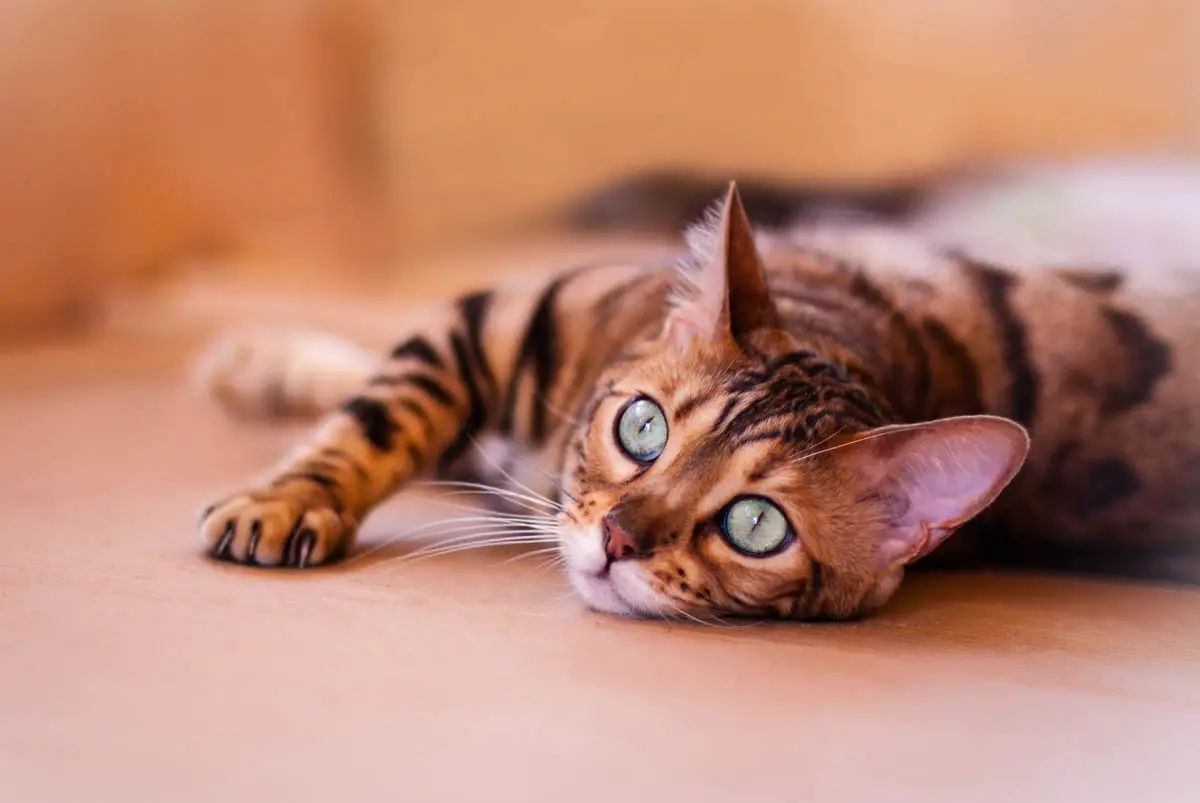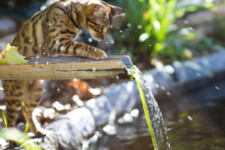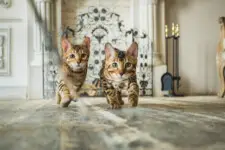How To Discipline a Bengal Cat Without Hurting Them
Bengal cats are exceptionally intelligent animals that are noted for their ability to communicate with humans through their behavior.
Punishment and other standard discipline approaches are ineffective for most cats, and different tactics such as re-direction or using certain distractions can work to correct unwanted behavior.
Disciplining your Bengal cat will be most effective if you attempt to understand why they are behaving in a manner you don’t want and create a plan to deal with it accordingly. Cats don’t know what bad behavior is, so encouraging good behavior is the most effective discipline method.
Understanding your Bengal cat is essential to determining the best approach to discipline for them.

Do Bengal Cats Respond to Discipline?
Bengal cats are very bright and will respond to discipline but only if it is the right form of discipline for their needs.
For instance, if you hit your cat when they do something wrong, they will not respond because they do not understand aggression.
On the other hand, if you praise them when they do something well, they will continue doing it and thus, respond to the positive re-enforcement discipline approach.
Why Do Bengal Cats Behave Badly?
Bengal cats usually behave badly because they aren’t happy with something, or it’s just a natural behavior that isn’t acceptable to you in your house.
The most common reason for their bad behavior is that their environment isn’t to their liking, or they aren’t getting something they want – and want to get your attention!
This could mean anything from the litter box placement being less than ideal for them, to them not liking their toys, or simply being bored.
We recommend evaluating their behavior and running a trial-and-error solution plan to see what needs to be changed and how they respond to the changes.
Essentially, you need to set up an environment that suits them, so they aren’t inclined to misbehave.
Is Corrective Behavior Effective for Bengal Cats?
Corrective behavior is the key to disciplining your Bengal cat.
As mentioned, Bengal cats are usually trying to tell you something through their behavior – so correcting it shows them that you’ve heard and are attempting to meet their needs in a manner that also works for you.
An Example of Corrective Behavior
For instance, if your Bengal cat continues to scratch your carpets, they need an outlet for scratching which is a common need for cats (an inbuilt trait to sharpen their claws for self-defense and hunting).
If you correct them each time they begin scratching by moving them to a designated scratching place (a specific rug or toy), then you are meeting their needs and they will eventually respond.
However, the way you go about this is very important.
- When they begin scratching the wrong area, you cannot yell, hit them, or act out in anger in any way, as it will not deter them but rather only scare and confuse them.
- You must remain calm and re-direct them toward the behavior you desire them to adopt.
- You must foster your trusting relationship which is built by understanding them and helping to satisfy their needs.
Discover more about Bengal cat personality in our Bengal cat guide.
Do Bengal Cats Respond to Aggressive Reactions?
Bengal cats do not understand aggression as a means of discipline. Anger confuses them or worse, frightens them. If they are constantly met with angry reactions, they can develop negative behaviors because they are confused and distressed.
If you yell or behave aggressively when they do something wrong, you are damaging your relationship with them.
Trust and affection are very important for your relationship with your cat to flourish and aggression does not cultivate these feelings.
Your cat will respond to you if they trust you. Bengal cats require affection more than other types of cats. They need to know they are loved.
This is another form of communication for Bengal cats. If their requirement for affection is met, they will behave better than if it’s not.
Common Undesirable Behaviors
Most of these solutions come down to the principles of positive reinforcement and re-direction.
The best rule of thumb is to analyze your cat’s behavior and consider why they are doing things you don’t want them to.
- If they’re scratching incessantly, find a new place for them to scratch that works for you.
- If they’re overly energetic, provide them with an energy outlet.
- If they’re getting into places they shouldn’t get into, deter them from those places by making them inaccessible.
The better you understand your cat, the better your solution to their behavioral problems will be.
Scratching Things to the Point of Ruining Them
Maybe you’ve come to this article because your curtains or doors are scratched beyond repair, or you’ve lost one too many sofas to your Bengal cat?
Unfortunately, incessant scratching is quite common for these cats.
The corrective behavior method is best in this case. Either choose a designated scratching area or buy a scratching post or scratching board for your cat.
Each time they start scratching away at the places they’re not allowed to, you simply re-direct them to the designated spot.
Again, this is simply an example of them telling you their needs. Cats need to scratch, it’s in their nature. So let them scratch, just make sure it’s not your sofa!
Jumping Up On the Countertop
Are you concerned about leaving wine glasses and other valuables on the counter for fear of your cat hopping up unexpectedly and shattering them?
Bengal cats can be bouncy and seem to particularly love kitchen counters and cabinets.
This is because Bengal cats have an instinct to jump to the highest places they can. It’s a survival mechanism. To curb this behavior, we suggest creating a yes/no environment.
This implies using tools, corrective behavior, and positive re-enforcement to build an environment where they know explicitly which areas are “yes” and which are “no”.
To create a “No” environment, you need to make the area one that your Bengal cat will associate with unpleasantness.
For instance, by placing double-sided sticky tape, or sticky pads on out-of-bounds surfaces they will learn to avoid them.
This tactic is one that uses classic conditioning to build a yes/no environment for your furry friend.
Opening and Getting into Drawers
Bengal cats are intelligent which is amazing in some ways and less amazing in others. For example, their ability to find their way into just about anything no matter the barrier is a form of intelligence that may not be so welcomed.
Firstly, think about what is in the drawers that is attracting them, whether it’s food, or just an interesting place to take a nap.
You can try re-organizing items to harder to reach places, or if that doesn’t work you may need to install latches or knobs that only humans can open.
Alternately try taping drawers shut for a while until your cat learns they’re off-limits and loses their interest in these areas, or get some locks like you would use for small children to keep them out.
Being Overly Energetic – Running Around the House
Bengal cats are hyperactive and are often jumping from counter to counter and running from room to room in seconds flat.
Cats are inherent hunters. It’s in their blood. They want to run, chase and capture. So, laying about the house all day simply won’t satisfy them.
There are many toys you can give your cat can play with, even simple things like a ball of aluminum foil or newspaper.
Laser pointers are particularly fun for cats, and you can sit on your lounge having a good laugh while your cat tires itself out playing in an area that you want it to.
A few rounds of this game and your Bengal cat will undoubtedly be less of a nuisance!
Toys filled with catnip can also work, as for some cats the effect of catnip is to calm them down and fill them with a feeling of divine contentment. A quiet kitty equals a happy you.
Another suggestion is to adopt Bengal cats in pairs. Having a companion means they can expend energy on each other rather than on running around your house. Because they’ll have similar energy levels, they’ll often play until they’re tired out.
Bengal kittens need a good environment to keep them content, see what to buy for a Bengal Kitten in this post.
Check Their Bad Behavior is Not Due to a Health Problem
Finally, we have discussed that Bengal cats are usually trying to tell you something through their behavior.
If your Bengal cat is repeatedly acting up and not responding to any of these suggested discipline tactics, you should take them to the vet and ensure their behavior is not indicative of a health issue.
Final Thoughts
Bengal cats are a beautiful breed, and their intelligence allows for a wonderful human-cat relationship.
Simply ensure that you listen to what they are trying to tell you through their behavior and then, devise the best disciple approach for them accordingly.
Each Bengal cat has their own way of expressing themselves, so get to know yours!




